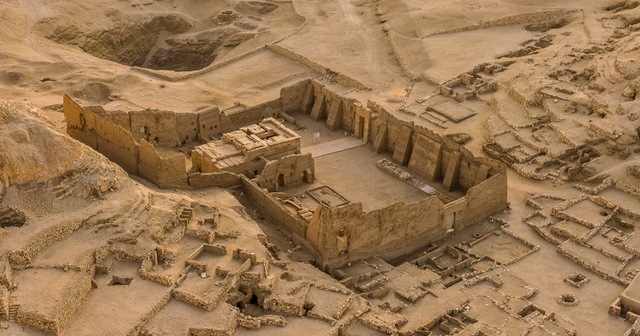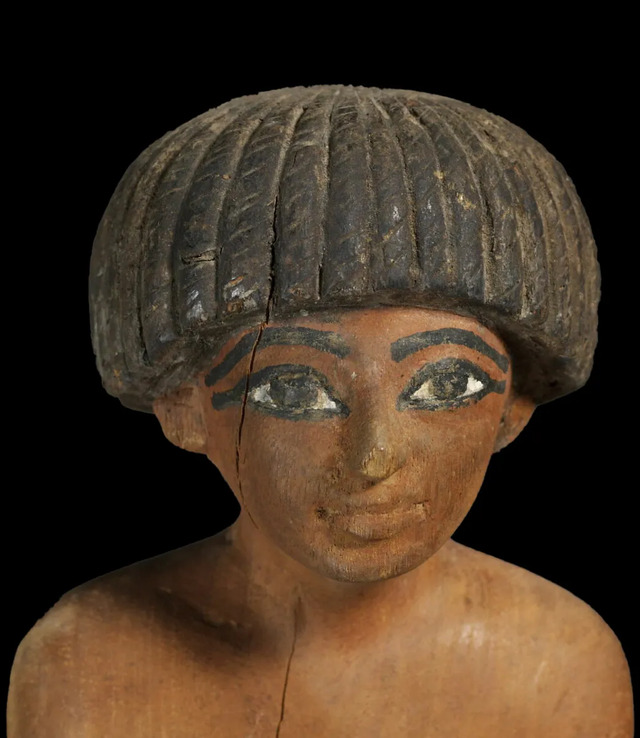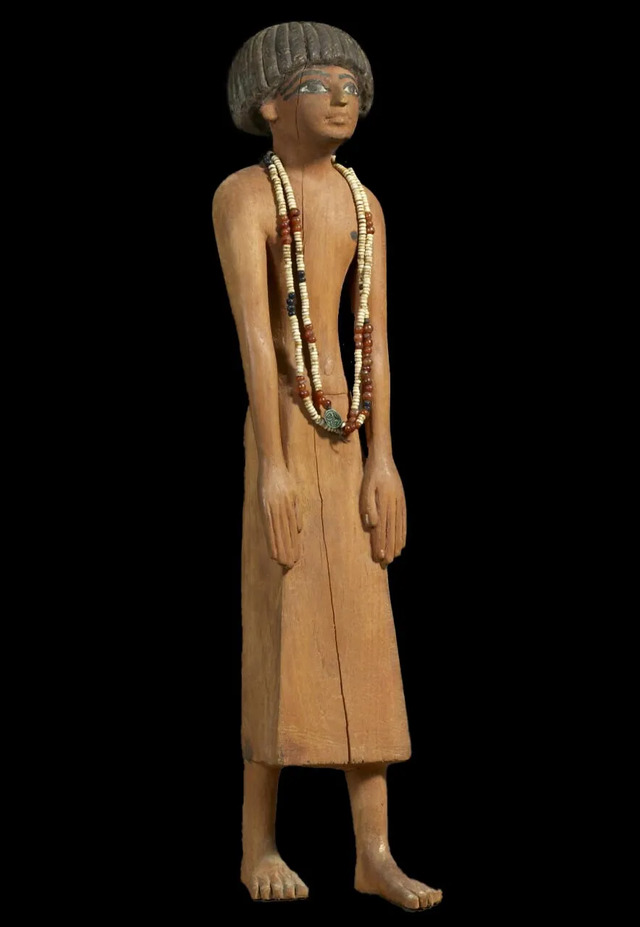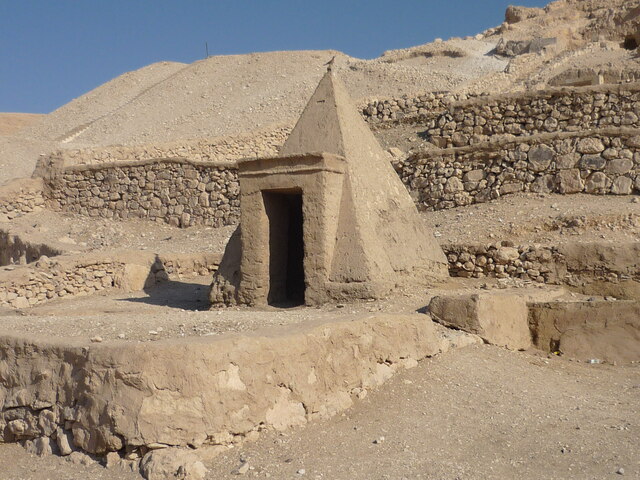Deep within the ancient burial grounds of Deir el-Medina, a small but significant tomb has revealed a fascinating glimpse into the lives of those who built Egypt’s grand monuments. Tomb 1379, home to the artisan Satnem, uncovers a rich legacy not just of craftsmanship, but of spiritual beliefs and a culture that revered the afterlife. Among the treasures found is a stunning statue of Satnem, carved from acacia wood, standing as a silent testament to the artistry and dedication of the ancient Egyptians. This statue, and the artifacts surrounding it, provide a rare window into the forgotten lives of those whose work helped shape one of the world’s greatest civilizations.
Satnem and Nub: Lives Preserved in Time
Deir el-Medina, during the New Kingdom (1550-1070 BCE), was home to a community of artisans responsible for the construction of the tombs for the pharaohs and nobles in the nearby Valley of the Kings. Tomb 1379, located in the East Cemetery of Deir el-Medina, provides us with a glimpse into the lives of those artisans, specifically Satnem and Nub. These individuals, whose lives were intertwined with the grand tombs of the Pharaohs, were buried in this modest cemetery with reverence for the afterlife that mirrored the extravagant funerary rites of their elite counterparts.

While not as famous as the royal tombs, the burial practices of Deir el-Medina’s artisans were still reflective of the deeply ingrained Egyptian belief in life after death. The modest but meaningful graves, often adorned with small but significant artifacts, continue to tell the story of a society that revered its workers and ensured they, too, would be provided for in the afterlife.
Video
Watch the video to discover the incredible craftsmen behind the construction of Egypt’s magnificent tombs, whose skill and artistry have stood the test of time.
The Statue of Satnem: An Artistic Masterpiece
The most striking artifact recovered from Tomb 1379 is the life-sized statue of Satnem, now housed at the Musée du Louvre in Paris. Carved from acacia wood, a material prized for its durability and resistance to decay, this statue exudes an air of solemnity and reverence. Satnem’s figure, dressed in the traditional garments of the time, is shown in a seated position with his hands resting gently on his knees. This pose suggests that the statue was likely intended to receive offerings during funerary rituals, acting as a bridge between the mortal realm and the divine.


The statue is inscribed with an offering formula, invoking sustenance and divine favor for the deceased in the afterlife. This was a crucial aspect of Egyptian funerary practices—ensuring that the deceased was well-cared for in their journey through the underworld. The offering formula highlights the importance of sustenance and divine protection, reflecting Egypt’s deep belief in the cyclical nature of life, death, and rebirth.
The meticulous craftsmanship of Satnem’s statue is a testament to the skill of Deir el-Medina’s artisans, who, though often in the shadows of their royal patrons, played an integral role in the creation of Egypt’s eternal monuments. Their work was not only functional but deeply symbolic, reflecting the reverence Egyptians held for their gods and the afterlife.
The Role of Acacia Wood in Ancient Egypt
Acacia wood, used for Satnem’s statue, holds great spiritual significance in ancient Egyptian culture. Native to Egypt and the broader regions of North and East Africa, acacia was highly prized for its durability and resistance to decay. But beyond its practical uses, acacia was also imbued with deep symbolic meaning. The tree was often associated with rebirth and protection, and it was closely linked to the goddess Isis, who was revered as a protector of the deceased and a goddess of magic and healing.
In Egyptian mythology, the acacia tree was sometimes described as the primordial source of life, reinforcing its sacred stature. This association with life, rebirth, and divine presence makes the use of acacia wood in Satnem’s statue even more poignant. The artisans of Deir el-Medina, aware of the tree’s spiritual significance, would have selected acacia not just for its durability, but for its symbolic connection to the divine forces that governed life and death.

Artefacts from Tomb 1379: A Glimpse into the Afterlife
Beyond the remarkable statue of Satnem, other artefacts recovered from his tomb further illuminate the spiritual practices of Deir el-Medina’s artisan class. Among these are ushabti figurines, small statues designed to serve the deceased in the afterlife by performing tasks on their behalf. These figurines, often inscribed with spells and prayers, were intended to ensure that the deceased would have all they needed for an eternity of service to the gods.
Additionally, painted relief fragments and remnants of ritualistic objects offer a window into the ceremonial practices that took place during the funerary rites. These objects, though modest compared to the treasures found in royal tombs, are just as significant in understanding the spiritual convictions and everyday life of those who built Egypt’s monumental structures. The presence of such items in Satnem’s tomb underscores the deep faith the artisans held in the life beyond death—a faith that transcended social class and found expression in the material culture they left behind.
Deir el-Medina: A Community of Artisans and Their Legacy
The community of Deir el-Medina stands as a testament to the artistry, skill, and dedication of the workers who helped construct Egypt’s grand monuments. While their tombs may be less grandiose than those of the Pharaohs, they reflect the same reverence for the afterlife. These artisans were not mere laborers; they were artists, craftsmen, and spiritual practitioners, whose work was intimately tied to Egypt’s beliefs in divine kingship and immortality.
Deir el-Medina was not only a physical home for these artisans but also a spiritual center. The artifacts recovered from the tombs of this community reveal a deep commitment to ensuring their place in the afterlife, often through the creation of statues, figurines, and other objects that would accompany them in their eternal journey. Their work, which helped shape the tombs of Egypt’s most powerful rulers, continues to be celebrated as a vital part of Egypt’s artistic legacy.
The East Cemetery: Mortality and Memory
The East Cemetery of Deir el-Medina, where Satnem and his fellow artisans were buried, stands as a poignant reminder of mortality’s reach. While the graves of children dominate much of the cemetery, the graves of esteemed artisans like Satnem provide a stark contrast. These tombs are not just places of burial but spaces of memory, where the lives of those who shaped Egypt’s monuments are preserved for future generations.
Satnem’s tomb, though less renowned than the grand tombs of the Valley of the Kings, remains an invaluable piece of Egypt’s mortuary landscape. The items discovered there, from the finely crafted statue to the ushabti figurines, offer modern scholars a glimpse into the spiritual convictions and aspirations of those who built the tombs of Egypt’s elite.

The Lasting Legacy of Satnem and His Tomb
Satnem’s tomb, though long forgotten, has offered us an extraordinary opportunity to delve into the lives and beliefs of ancient Egypt’s artisan class. Through the preservation of his statue and other artefacts, we can better understand the spiritual practices of the workers who helped to create Egypt’s eternal monuments. In uncovering the tomb of Satnem, we are reminded of the importance of those whose names may have been lost to time but whose legacies live on through the art and artifacts they left behind.
Video
Watch the video to explore the fascinating Deir el-Medina, the ancient Egyptian workers’ tombs and city, revealing the lives of those who built the pharaohs’ monuments.
Conclusion: The Enduring Echo of Ancient Egypt’s Artisan Class
The discovery of Satnem’s tomb and the recovery of his statue mark an important moment in the study of ancient Egypt. These findings reveal not just the lives of individual artisans but also the broader cultural and spiritual beliefs of a society that valued craftsmanship, artistry, and the afterlife. Satnem’s legacy, preserved in wood and stone, continues to captivate scholars and enthusiasts alike, reminding us that the history of ancient Egypt is not just the story of its rulers but also the story of the people who helped build its enduring monuments.



